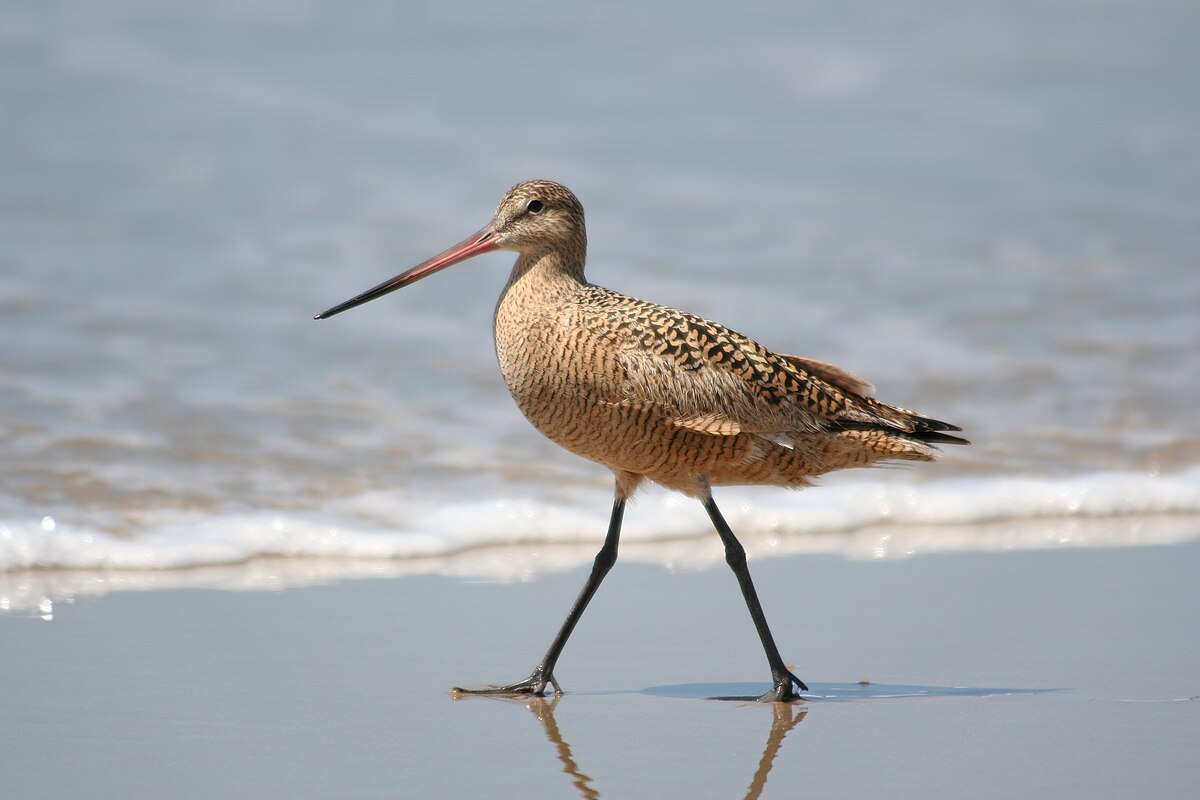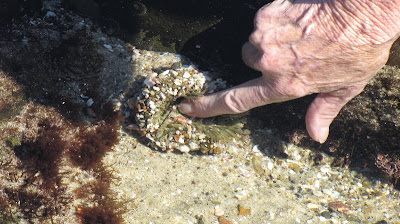These pictures were taken yesterday. The sun was shining and the air was warm. This morning we found a very different beach.
The marine layer was thick this morning. Fog always reminds me of Aunt Bette. She used to always say that each morning was foggy in Santa Cruz. It certainly was foggy today. We could not see very far when walking on the beach.

Looking toward the pier.
Looking out at the ocean. We saw only two brave or foolish souls who were out in the ocean surrounded by fog.
Looking back towards the parking lot.
There are houses behind me.
Finally getting close enough to see Scripps Pier.
We have never seen the tide out as far as it was this morning. Low tide was just after six and we got to the beach just a bit after seven in the morning.
Tips for visiting La Jolla Shores
Tide Pool Etiquette
Good tide pooling etiquette is absolutely necessary to protect these gems.
Take only pictures, leave only footprints is a good thing to keep in mind.
— - Danny Beckwith, Education Specialist at Birch Aquarium
- Most of La Jolla’s coastline is in a Marine Protected Area. This means that you may not remove any marine objects, whether living or dead, from these areas.
- Watch out for algae-covered rocks. If it’s green, brown or black, avoid stepping on it or tread lightly.
- Whatever you bring in, take back out. If you move anything like a rock, put it back. An animal might us using it for an habitat.
- Never turn your back on the ocean. It’s easy to get excited and not see a wave coming.
- If you’re going to touch something, exercise caution. Be aware of what might be on your hands like hand sanitizers or other chemicals that may be harmful to animals. If you’re unsure of what something is, the best practice is not to touch it. Always rinse your hands off first and only touch for only a few seconds.
The posts of the pier are always covered with barnacles and mussels. Today we saw this strange growth on the pylons. It was orange and springy when I touched a piece. In another area, the growth was more firm but definitely not a relative of any shell creatures that we are accustomed to seeing on the beach and in the tide pools. I wish the pictures were more clear.
When we walked past the pier, we felt as if we were in an unknown land on a beach we had never seen before. The water had receded so far that we could see a field of moss covered rocks. The ocean floor was fairly flat but we had no idea that under the water we are used to seeing was an army of rocks.
Taken from the vantage point where we walked among the
rocks.
This is the ocean side of a rock we are very familiar with. We have never seen it before because the ocean has never ebbed so far from the rocks and shore. Usually, it is covered with water too deep for us to wade around and frequently the ocean is too rough to feel safe venturing out to this side.
This is a completely different type of plant growth than we are accustomed to seeing. It looks like lush green grass. We are used to the brown kelp with lots of bubble shaped attachments.
One of our bird friends. The other picture on this page was taken in the sunshine at the other end of the beach.
The rocks are excellent spots for the
crabs to play hide and seek. Once in awhile, we will see a larger crab with distinctive pink claws.
This is a sea slug. It has the antennae of a snail but obviously, has no shell. It is under a shallow layer of water and it kept writhing and moving about. It took us awhile to figure out which end was the head.
This is a Navanax. It's a sea slug from the family Aglajidae. It is not a nudibranch! Seen at the Dike Rock tide pools, La Jolla, CA
This site has incredible pictures and caves and places to explore that I never imagined. I am sure anyone in my family would enjoy looking at these pictures. There is even a very good shot of the castle.
This is the side of the hole in the rock that we are familiar with. We have seen it when the water was low and when it was splashing wildly against the rock. This is the first time we have seen it without any water at all.
A sea filled with rocks that we were completely unaware existed.
The castle in the fog
This picture was taken at the rocky area south of the castle. All of these are sea anemones. We saw very few walking at the other end of the beach.
A
gentle touch or a gentle tickle to a sea anemone causes it to close anticipating catching prey.
The hotel was getting ready for the children's play day at the club.
There are several patches of flowers growing on the ledges of the artificial rock. We have no idea how they survive but they are flourishing. I am glad no one wants me to climb down or up to see how the plants are doing.

I found this picture of
the pier and couldn't resist adding it and this picture of kelp from a different perspective.




























































